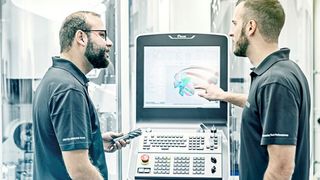Why Intuitive CNC Programming Interfaces Are So Important
At UNITED GRINDING, our consultative approach to our relationship with our customers includes listening to their challenges, wide-ranging and specific. That valuable feedback helps our research and development team build even more powerful and impactful grinding machines and supporting software. One of the things that has challenged manufacturers for years — as they contemplate retraining and hiring the next generation of machine tool operators — is the question of how to transfer CNC programming knowledge.
In other words, how can increasingly younger and newer staff begin to understand how this more complicated equipment works and how to use it?
Intuitive CNC programming interfaces provide a possible solution. An easy-to-use Human Machine Interface (HMI) builds more technical expertise into the machine itself, as opposed to relying on tribal knowledge being passed on through the shop.
HMIs Help Optimize Human Capital, Provide Window into Operations
HMIs are critical for CNC programming, diagnostics, troubleshooting, and changeovers. The benefits of HMIs begin with two key areas:
- Make it easier and more efficient for manufacturers to train their newest employees how to program and monitor their most sophisticated machines, freeing up valuable skilled workers to be deployed elsewhere. This also will improve workforce retention and help address the skilled labor shortage.
- Provide a window into production systems to enable operational improvements and equipment optimization. This becomes more important as more machine sensors are tied into a network, providing more real-time information on operations and equipment.
The HMI itself is just a device; it is dependent upon an operating system and associated software. When optimized, HMI benefits include:
- Allowing processes to be more easily combined, which can become a huge savings for cycle times and changeovers.
- Avoiding rework — shops can run simulations to avoid many problems that might arise during actual part runs.
- Systems integration — the collection of shop-floor data from sensors is becoming more important for real-time monitoring, as is the desire to connect with ERPs and other digital infrastructure.
End of the Line for CNC Programming with a Mouse and Keyboard
Most first-generation HMIs used for CNC programming and machine tooling are operationally complex, designed with an expert operator in mind, which means it is easier for an inexperienced operator to make a mistake. The physical designs of these HMIs also are more Baby Boomer–friendly, with traditional buttons and PC functionality such as a mouse and keyboard.
Historically a shop floor machine operator might work on a machine for a long time, developing expertise in the idiosyncrasies of the equipment and process. But today operators are not so deep in programming and technical expertise since they are often expected to operate or monitor more varieties of machines in a production cell.
Also, many HMIs are brand specific, which means operators may have to learn several different systems in order to supervise a production cell. This also impacts service technicians.
Changing the ‘I’ in HMI from Interface to Interaction
At UNITED GRINDING, we believe future CNC programming HMIs will need to provide our customers and their operators with a sense of confidence and confirmation that they are getting the highest performance out of their grinding technology. Operators want to have trust in the machine and know that it is easy to use. We plan to accomplish this by heightening the interaction between the operator and the HMI.
Modern machine tool HMI design will become more friendly to younger employees with these types of features:
- Multi-touch screen capabilities
- Touching an icon
- Simulating or directing an action
- Swiping motions to advance through steps and displays
- Portability
- Tablets, smartphones or other devices than can stay with the operator anywhere on the shop floor, or beyond
- Personalization
- An operating system will know the level of expertise of each operator and limit the HMI parameters in which he or she operates
- Features could be unique to a user or user-machine combination
HMIs will allow devices to issue real-time notifications, such alerts that let operators know when a machine is running low on blanks or needs maintenance.
Also, expect the next generation of CNC programming HMIs to be more uniform and operation-system agnostic.
Choose the Right Partner to Get the Most Out of Your Grinding Technology
HMIs are only beginning to scratch the surface of interaction. As automation adoption increases, more sensors will be connected and networked, and lights-out manufacturing will be more common. As manufacturing becomes more digitized, the potential for HMIs will expand to include speech recognition, eye and gesture tracking and motion sensing. Algorithms will soon help you determine which machine is best for which production run.
Here at UNITED GRINDING, engineers and programmers are hard at work to develop the next generation of CNC programming HMIs that will make more complex machines and applications even easier to use.
Contact us today to discuss how we can collaborate to solve your challenges and get the most out of your grinding technology.









